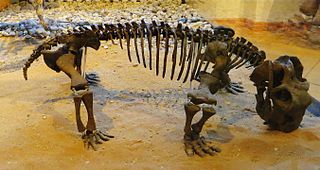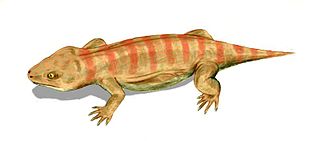 W
WCynognathus is an extinct genus of large-bodied cynodontian therapsids that lived in the Middle Triassic. It is known from a single species, Cynognathus crateronotus. Cynognathus was a 1.2-metre long predator closely related to mammals and had a southern hemispheric distribution. Fossils have so far been recovered from South Africa, Argentina, Antarctica, and Namibia.
 W
WDiademodon is an extinct genus of cynodonts. It was about 2 metres (6.6 ft) long. Although Diademodon is the most well accepted name for the genera to date, it was originally named Cynochampsa laniarius by Owen in 1860. The proposed name change occurred in 1982, where Grine defended the name proposed by Harry Seeley: Diademodon tetragonus and to be place in the group Therapsida, which was a group Owen had tiptoed around in his works on paleontology. Though Harry Govier Seeley had named Diademodon in 1894, which was after Owen had dubbed the genus Cynochampsa, Seeley had not realized the two were one and the same as the fossil that Owen named was claimed to have been found in a claystone nodule in the Renosterberg Mountains. A later paleontologist explored the same area where the fossil was claimed to have been found and declared no evidence of Cynognathus fossils.
 W
WEriciolacerta is an extinct genus of small therocephalian therapsids from the early Triassic of South Africa and Antarctica. It was around 20 centimetres (7.9 in) in length, with long limbs and relatively small teeth. It probably ate insects and other small invertebrates.
 W
WThe Fremouw Formation is a Triassic-age rock formation in the Transantarctic Mountains of Antarctica. Fossils of prehistoric reptiles and amphibians have been found in the formation. Fossilized trees have also been found. The formation's beds were deposited along the banks of rivers and on floodplains. During the Triassic, the area would have been a riparian forest at 70–75°S latitude.
 W
WLystrosaurus was a herbivorous genus of dicynodont therapsids from the late Permian and Early Triassic epochs. It lived in what is now Antarctica, India, China, Mongolia, European Russia and South Africa. Four to six species are currently recognized, although from the 1930s to 1970s the number of species was thought to be much higher. They ranged in size from that of a small dog to 2.5 meters long.
 W
WMyosaurus is an extinct genus of dicynodont found primarily in Antarctica and South Africa.
 W
WProcolophon is a genus of lizard-like procolophonid reptiles that first appeared in the Late Permian (Lopingian) of South Africa, Brazil, and Antarctica. It persisted through the Permian–Triassic extinction event, but went extinct in the early Triassic. The type species is P. trigoniceps.
 W
WThrinaxodon is an extinct genus of cynodonts, most commonly regarded by its species T. liorhinus which lived in what are now South Africa and Antarctica during the Early Triassic. Thrinaxodon lived just after the Permian–Triassic mass extinction event, its survival during the extinction may have been due to its burrowing habits.